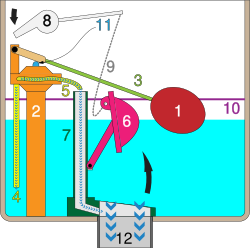Dick and Natalie Gordon have started a course Embryogenesis Explained in Second Life.
The course is based on the book that they write. The first lecture was ‘How Embryogenesis Began in Evolution‘ and it corresponds to the first chapter in the book. I should say that I like the lecture as well as the draft of the chapter.
However I am a bit troubled by a statement ‘Three fundamental first life processes would be replication, movement and perception‘. I should say that I do not understand what it means that for example bacteria can perceive. I have asked a question if an automatic door has perception and the answer was yes. Well, everything is matter of definitions and below I consider different situation with artificial systems in order to better understand the meaning of ‘bacteria can perceive‘.
In my personal view, the situation when a bacterium perceives and moves corresponds to a system with feedback. The simplest are mechanical systems with feedback, for example a ballcock (picture from Wiki – Ballcock)

The question here is evident. Could we say, that a ballcock perceives? What is the difference with a bacterium (let us not consider replication, in my view it is not essential at this point)?
The most technical systems however (for example an automatic door) have sensors, electronic controllers and actors. The most famous controller is the PID one (proportional–integral–derivative controller)

Feedback with a controller (PID), picture from Wiki – PID controller.
The best example for a system with sensors, controllers and actors is a robot and my favorite robot is Big Dog
http://www.youtube.com/watch?v=cHJJQ0zNNOM
As it is an artificial system, we know exactly how it is made and how it functions. This is the reason that nowadays some scientists even use robots to study the behavior of animals. I will cite from Dario Floreano and Claudio Mattiussi, ‘Bio-Inspired Artificial Intelligence: Theories, Methods, and Technologies‘, 2008, Chapter 6 ‘Behavioral Systems‘, section 6.5 Robots as ‘Biological Models‘.
‘Robots can also be used as models to investigate biological questions and test hypothesis. As we mentioned in the historical introduction to this chapter, robots have been gradually replacing computers as the preferred tool and metaphor in embodied cognitive science. Robots are becoming increasingly accepted also among experimental biologists and neurosciences as tools to validate their models.’
I do not have a nerve to make definitions but I hope that my text will help to define more precisely the statement ‘bacteria can perceive‘. Finally I should say that in relationship with perception philosophers also discuss such a property as qualia. A good text about qualia is in Stanford Encyclopedia of Philosophy
http://plato.stanford.edu/entries/qualia/
An interesting question to this end is considered in section 8: ‘Which Creatures Undergo States with Qualia?‘ Does a bacterium already has qualia?
Discussion
http://groups.google.com/group/embryophysics/t/dcfc75b0bd41d1d0
http://groups.google.com/group/everything-list/t/1dadda0d2b84f605
Brent:
‘That seems to be a question for the makers of dictionaries. We know that the automatic door receives input from it’s environment and acts on it. Do we want to call that “perceiving”? We could. Or we could reserve “perceiving” to cases were there is memory and learning, e.g. an automatic door that learns face recognition. Or we could also require that there be some self-awareness, e.g. an automatic door that runs a BIT before either working or reporting a problem with its mechanism. This is part of my point that when we have fully developed, engineering level understanding of intelligence and consciousness we will see them as very complex, multi-dimensional subjects. That is one reason I do not embrace Bruno’s idea that every Lobian computing machine is equally intelligent and conscious. That may be true, but in some abstract, uninteresting sense.’
My answer.
Nowadays one can imagine an intelligent automatic door with many functions, for example when I say Remember it stores my image. Additionally it will open itself only for persons that it remembers. That is, it will open itself not for everybody. I believe that such functionality is already reality. So the question is the same. If such an intelligent door perceives? I also agree that this is also a matter of definitions, but this would be the goal of the example, to define Perception better in a more definite way. I would suggest along this way to introduce conscious perception and unconscious perception, and I would state that such a door could have unconscious perception but not conscious.
Even a better example would be Big Dog. Here it would be hard to say that Big Dog does not perceive. Yet the question remains if this perception still unconscious, or one already can find some elements of conscious perception.
Then we can ask ourselves the same for insects, and finally go onward along the tree of life.
____
Yes, but I have meant perception only. Well, one could say that a bacteria perceives that it is time to divide and Big Dog cannot perceive something like this. In my current world view however “a bacteria divides” is closer to a ballcock that closes the water. I mean that division of a bacteria is probably based on some feedback mechanism as well.
Here though there is an interesting question. After all, one can implement a PID controller with analog electronics, so this way it is very close to a ballcock as well. Hence when I state that Big Dog more advanced there is some contradiction indeed, as finally it is just a collections of feedback mechanisms. Or digital processing as such gives us something new as compared with a ballcock?